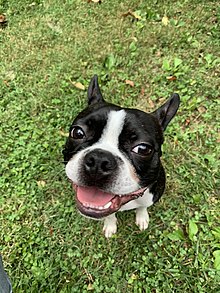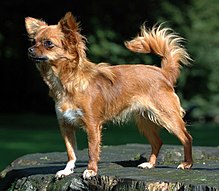
A jewel of Russian canine heritage, the Russian Toy, formerly known as the Russian Toy Terrier, is a diminutive breed that exudes elegance and charm. With its delicate features, large bat-like ears, and spirited gaze, this toy breed was historically the favored companion of Russian aristocracy. Though small in stature, the Russian Toy possesses a big heart, known for its unwavering loyalty, keen intelligence, and lively disposition, making it a treasured lapdog and devoted companion.
The Russian Toy is a member of the AKC Toy Group.
Breed Characteristics
| Dog Breed | Russian Toy |
| Breed Popularity (AKC) | 144 |
| Country of Origin | Russia |
| Personality | Friendly |
| Life Expectancy | 12-14 yrs |
| Height | 8-11 in |
| Weight | 6-6 lbs |
| Color | Red & Brown, Black & Tan, Blue & Tan, Red Sable, Red, Brown & Tan, Fawn, Cream, Lilac |
| Coat | Short, double |
| Shedding | Infrequent |
| Grooming | Weekly Brushing |
| Health Problems | Patellar luxation, progressive retinal atrophy |
| Trainability | Agreeable |
| Exercise Needs | Regular Exercise |
Russian Toy History
Emerging from Russia, the Russian Toy is a small toy breed with roots dating back to the Russian aristocracy of the 17th century. Bred primarily as a companion and watchdog for the nobility, it faced near-extinction during the Soviet era but has since made a comeback. They are known for their delicate appearance and spirited nature.
Temperament
Russian Toys, one of the smallest breeds, are lively and devoted. Their intelligence and alertness make training a fun experience. Their behavior is affectionate and somewhat protective, often forming strong attachments to one person. They have a moderate energy level, thriving on indoor play and short walks. Proper socialization ensures they stay balanced. Their barking tendencies are pronounced, frequently vocalizing when alerted or seeking attention.
Remember, while breed traits provide a general idea, individual dogs can have personalities that differ from the breed standard. Always spend time getting to know the dog and ensure their needs and temperament align with your lifestyle.
Grooming Requirements
Russian Toys possess a short to medium-length coat that needs occasional brushing to remove loose hairs. A dog shampoo suitable for their coat type is beneficial during their infrequent baths. Essential grooming routines include nail trimming, ear cleaning, and checks for skin conditions.
Russian Toy Health
Russian Toys, living 10-12 years, might experience health issues such as patellar luxation and progressive retinal atrophy. Regular health checks, vaccinations, flea prevention, and deworming are key. Their diet should be nutritious, tailored for their size, and potential allergies should be observed.
Exercise Needs
Russian Toys, though small, are lively and enjoy walks and play sessions tailored to their size. A dog park might offer a chance for socializing, but it’s essential to ensure they aren’t overwhelmed by larger breeds. Bonding through relaxed playtime or gentle agility exercises can be suitable for this small yet energetic breed.
Training
Small in stature but big in personality, the Russian Toy is charming and lively. Gentle obedience training suits their delicate nature. Commands, especially for potty training, should be delivered with patience. Crate training provides a cozy nook for these little gems. Addressing behavior problems, like their occasional yappiness, is essential. Thorough socialization ensures they maintain their affable temperament.
Russian Toy Pictures
Related Dog Breeds
More Dog Resources
Are you thinking about getting a puppy? Make sure to check out our list of important questions to ask before you adopt a puppy.
We also have many resources to help, from naming your puppy to socialization resources and training tips.
Take me back to the Ultimate Guide to Dog Breeds



